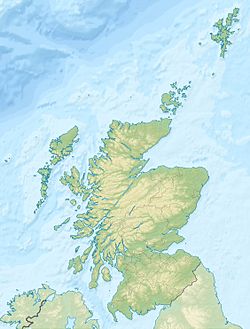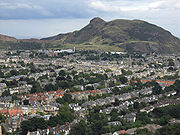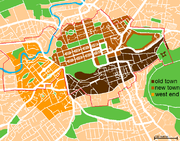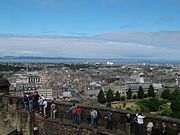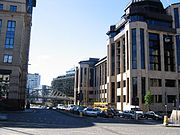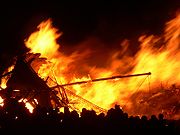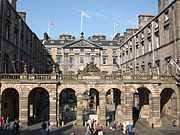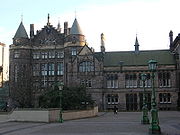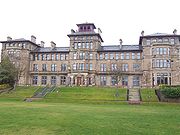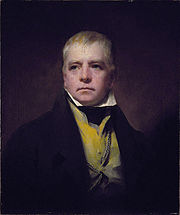
Edinburgh
Background to the schools Wikipedia
This content from Wikipedia has been selected by SOS Children for suitability in schools around the world. See http://www.soschildren.org/sponsor-a-child to find out about child sponsorship.
| Edinburgh Scottish Gaelic: Dùn Èideann Scots: Edinburgh |
|||
|---|---|---|---|
| — Unitary Authority & City — | |||
| City of Edinburgh | |||
|
|||
| Nickname(s): "Auld Reekie", "Athens of the North" | |||
| Motto: "Nisi Dominus Frustra" "Except the Lord in vain" associated with Edinburgh since 1647, it is a normal heraldic contraction of a verse from the 127th Psalm, "Except the Lord build the house, they labour in vain that build it. Except the Lord keep the city, the watchman waketh but in vain" | |||
|
|
|||
| Coordinates: 55°56′58″N 3°9′37″W Coordinates: 55°56′58″N 3°9′37″W | |||
| Sovereign state | United Kingdom | ||
| Country | Scotland | ||
| Council area | City of Edinburgh | ||
| Lieutenancy area | Edinburgh | ||
| Admin HQ | Edinburgh City Centre | ||
| Founded | prior to the 7th century | ||
| Burgh Charter | 1125 | ||
| City status | 1889 | ||
| Government | |||
| • Type | Unitary Authority, City | ||
| • Governing body | The City of Edinburgh Council | ||
| • Lord Provost | George Grubb | ||
| • MSPs |
6
|
||
| • MPs: |
5
|
||
| Area | |||
| • Total | 100.00 sq mi (259.0 km2) | ||
| Population (2009) | |||
| • Total | 477,660 | ||
| • Urban density | 4,776/sq mi (1,844/km2) | ||
| Time zone | Greenwich Mean Time ( UTC+0) | ||
| • Summer ( DST) | British Summer Time ( UTC+1) | ||
| Postcode | EH | ||
| Area code(s) | 0131 | ||
| ISO 3166-2 | GB-EDH | ||
| ONS code | 00QP | ||
| OS grid reference | NT275735 | ||
| NUTS 3 | UKM25 | ||
| Website | www.edinburgh.gov.uk (Official Council site) www.edinburgh-inspiringcapital.com (Visitor-facing site) |
||
Edinburgh ( / ˈ ɛ d ɪ n b ʌ r ə / ED-in-brə; Scottish Gaelic: Dùn Èideann) is the capital city of Scotland, the second largest city in Scotland and the seventh-most populous in the United Kingdom. The City of Edinburgh Council is one of Scotland's 32 local government council areas. The council area includes urban Edinburgh and a 30-square-mile (78 km2) rural area.
Located in the south-east of Scotland, Edinburgh lies on the east coast of the Central Belt, along the Firth of Forth, near the North Sea. Owing to its spectacular, rugged setting and vast collection of Medieval and Georgian architecture, including numerous stone tenements, it was considered by Sir John Betjeman one of the most beautiful cities in Europe.
Edinburgh is the seat of the Scottish Parliament. The city was one of the major centres of the Enlightenment, led by the University of Edinburgh, earning it the nickname Athens of the North. The Old Town and New Town districts of Edinburgh were listed as a UNESCO World Heritage Site in 1995. There are over 4,500 listed buildings within the city. In May 2010, it had a total of 40 conservation areas covering 23% of the building stock and 23% of the population, the highest such ratios of any major city in the UK. In the 2009 mid year population estimates, Edinburgh had a total resident population of 477,660.
The city is well-known for the annual Edinburgh Festival, a collection of official and independent festivals held annually over about four weeks from early August. The number of visitors attracted to Edinburgh for the Festival is roughly equal to the settled population of the city. The most famous of these events are the Edinburgh Fringe (the largest performing arts festival in the world), the Edinburgh International Festival, the Edinburgh Military Tattoo, and the Edinburgh International Book Festival. Other events include the Hogmanay street party, Burns Night and the Beltane Fire Festival. Edinburgh attracts 1 million overseas visitors a year, making it the second most visited tourist destination in the United Kingdom, after London.
Etymology
Some believe that the name of Edinburgh comes from the Brythonic language. Some propose that the name was Din Eidyn (Fort of Eidyn) from the time when it was a Gododdin hillfort although many believe that the name comes from the Bernician Angles, Edwinesburh or Edin-burh, which derives from the Anglo-Saxon for "Edwin's fort", possibly derived from the 7th century king Edwin of Northumbria, and that the name Din Eidyn in British writings is an anachronism. The term Din Eidyn first appears in the Y Gododdin, a poem which appears after the fall of the British stronghold to the Angles. The oldest manuscript of the Y Gododdin, The Book of Aneirin, dates from the mid to late 13th century.
The first evidence of the existence of the town as a separate entity from the fort lies in an early 12th century royal charter, generally thought to date from 1124, by King David I granting land to the Church of the Holy Rood of Edinburgh. This suggests that the town came into official existence between 1018 (when King Malcolm II secured the Lothians from the Northumbrians) and 1124. By the 1170s King William the Lion was using the name "Edenesburch" in a charter (in Latin) confirming the 1124 grant of David I.
History
Humans have settled the Edinburgh area from at least the Bronze Age, leaving traces of primitive stone settlements at Holyrood, Craiglockhart Hill and the Pentland Hills for example. Influenced through the Iron Age by Hallstatt and La Tene Celtic cultures from central Europe, by the time the Romans arrived in Lothian at the beginning of the 1st millennium AD, they discovered a Celtic, Brythonic tribe whose name they recorded as Votadini, likely to be a Latin version of the name they called themselves.
The Angles of Northumbria had a significant influence over south east Scotland, notably from AD 638 when it appears the Gododdin stronghold was besieged. Though far from exclusive (cf Picts and Scots), this influence continued over three centuries. It was not until c. AD 950 when, during the reign of Indulf, son of Constantine, the city, referred to at this time in the Pictish Chronicle as 'oppidum Eden', fell to the Scots and finally remained under their jurisdiction. During this period of Germanic influence in south east Scotland, when the city's name gained its Germanic suffix, 'burgh', the seeds for the language we know today as Scots were sown.
By the 12th century Edinburgh was well established, founded upon the famous castle rock, the volcanic crag and tail geological feature shaped by 2 million years of glacial activity. Flourishing alongside it to the east, another community developed around the Abbey of Holyrood, known as Canongate. In the 13th century these both became Royal Burghs and through the late medieval period Edinburgh grew quickly. Edinburgh continued to flourish economically and culturally through the Renaissance period and was at the centre of the 16th century Scottish Reformation and the Wars of the Covenant a hundred years later.
In 1603 King James VI of Scotland succeeded to the English and Irish thrones, uniting the Kingdoms in a personal union known as the Union of the Crowns. Scotland remained an independent state with the Parliament of Scotland in Edinburgh. King James VI progressed to London establishing his court there from which he reigned over his kingdoms. Despite promising to return every three years, he returned to Edinburgh only once, in 1617.
Disputes between the Presbyterian Covenanters and the Anglican Church in 1639 led to the Bishops' Wars, the initial conflict of the Wars of the Three Kingdoms. During the Third English Civil War Edinburgh was taken by the Commonwealth forces of Oliver Cromwell prior to Charles II's eventual defeat at the Battle of Worcester. In 17th century Edinburgh, a defensive wall, built in the 16th century, largely as protection against English invasion following James IV's defeat at Flodden (hence its moniker, the Flodden Wall) still defined the boundaries of the city. Due to the restricted land area available for development, the houses increased in height instead. Buildings of 11 stories were common and there are records of buildings as high as 14 or even 15 stories, an early version of the modern-day skyscraper. Many of the stone-built structures can still be seen today in the Old Town.
In 1706 and 1707 the Acts of Union were passed by the Parliaments of England and Scotland uniting the two Kingdoms into the Kingdom of Great Britain. As a consequence, the Parliament of Scotland merged with the Parliament of England to form the Parliament of Great Britain, which sat at Westminster in London. The union was opposed by many Scots at the time and this led to riots within the city.
From early times, and certainly from the 14th century, Edinburgh (like other royal burghs of Scotland) used armorial devices in many ways, including on seals. In 1732, the 'achievement' or 'coat of arms' was formally granted by the Lord Lyon King of Arms. These arms were used by Edinburgh Town Council until the reorganisation of local government in Scotland in May 1975, when it was succeeded by the City of Edinburgh District Council and a new coat of arms, based on the earlier one, was granted. In 1996, further local government reorganisation resulted in the formation of the City of Edinburgh Council, and again the coat of arms was updated.
During the Jacobite rising of 1745, Edinburgh was briefly occupied by Jacobite forces before their march into England.Following their ultimate defeat at Culloden, there was a period of reprisals and pacification, largely directed at the Catholic Highlanders. In Edinburgh the Hanoverian monarch attempted to gain favour by supporting new developments to the north of the castle, naming streets in honour of the King and his family; George Street, Frederick Street, Hanover Street and Princes Street, named in honour of George III's two sons.
The city was at the heart of the Scottish Enlightenment. Celebrities from across the continent would be seen in the city streets, among them famous Scots such as David Hume, Walter Scott, Robert Adam, David Wilkie, Robert Burns, James Hutton and Adam Smith. Edinburgh became a major cultural centre, earning it the nickname Athens of the North because of the Greco-Roman style of the New Town's architecture, as well as the rise of the Scottish intellectual elite who were increasingly leading both Scottish and European intellectual thought.
In the 19th century, Edinburgh, like many cities, industrialised, but did not grow as fast as Scotland's second city, Glasgow, which replaced it as the largest city in the country, benefiting greatly at the height of the British Empire.
The Scotland Act 1998 which came into force in 1999 established a devolved Scottish parliament and Scottish Executive, both based in Edinburgh responsible for governing Scotland, with reserved matters such as defence, taxation and foreign affairs remaining the responsibility of Westminster.
Geography
Bounded by the Firth of Forth to the north and the Pentland Hills, which skirt the periphery of the city to the south, Edinburgh lies in the eastern portion of the Central Lowlands of Scotland. The city sprawls over a landscape which is the product of early volcanic activity and later periods of intensive glaciation. Igneous activity between 350 and 400 million years ago, coupled with faulting led to the dispersion of tough basalt volcanic plugs, which predominate over much of the area. One such example is Castle Rock which forced the advancing icepack to divide, sheltering the softer rock and forming a mile-long tail of material to the east, creating a distinctive crag and tail formation. Glacial erosion on the northern side of the crag gouged a large valley resulting in the now drained Nor Loch. This structure, along with a ravine to the south, formed an ideal natural fortress which Edinburgh Castle was built upon. Similarly, Arthur's Seat is the remains of a volcano system dating from the Carboniferous period, which was eroded by a glacier moving from west to east during the ice age. Erosive action such as plucking and abrasion exposed the rocky crags to the west before leaving a tail of deposited glacial material swept to the east. This process formed the distinctive Salisbury Crags, which formed a series of teschenite cliffs located between Arthur's Seat and the city centre. The residential areas of Marchmont and Bruntsfield are built along a series of drumlin ridges located south of the city centre which were deposited as the glacier receded.
Other viewpoints in the city such as Calton Hill and Corstorphine Hill are similar products of glacial erosion. The Braid Hills and Blackford Hill are a series of small summits to the south west of the city commanding expansive views over the urban area of Edinburgh and northwards to the Forth.
Edinburgh is drained by the Water of Leith, which finds its source at the Colzium Springs in the Pentland Hills and runs for 29 kilometres (18 mi) through the south and west of the city, emptying into the Firth of Forth at Leith. The nearest the river gets to the city centre is at Dean Village on the edge of the New Town, where a deep gorge is spanned by the Dean Bridge, designed by Thomas Telford and built in 1832 for the road to Queensferry. The Water of Leith Walkway is a mixed use trail that follows the river for 19.6 kilometres (12.2 mi) from Balerno to Leith.
Designated in 1957, Edinburgh is ringed by a green belt stretching from Dalmeny in the west to Prestongrange in the east. With an average width of 3.2 kilometres (2 mi) the principal objective of the green belt was to contain the outward expansion of Edinburgh and to prevent the agglomeration of urban areas. Expansion within the green belt is strictly controlled but developments such as Edinburgh Airport and the Royal Highland Showground at Ingliston are located within the zone. Similarly, urban villages such as Juniper Green and Balerno sit on green belt land. One feature of the green belt in Edinburgh is the inclusion of parcels of land within the city which are designated as green belt even though they do not adjoin the main peripheral ring. Examples of these independent wedges of green belt include Holyrood Park and Corstorphine Hill.
Areas
| Old and New Towns of Edinburgh | |
|---|---|
| Name as inscribed on the World Heritage List | |
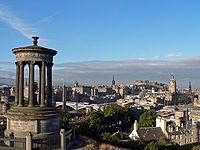 |
|
| Country | Scotland |
| Type | Cultural |
| Criteria | ii, iv |
| Reference | 728 |
| UNESCO region | Europe and North America |
| Inscription history | |
| Inscription | 1995 (19th Session) |
Edinburgh, the capital of Scotland, is divided into areas that generally encompass a park (sometimes known as " links"), a main local street (i.e. street of local retail shops), a high street (the historic main street, not always the same as the main local street, such as in Corstorphine) and residential buildings. In Edinburgh many residences are tenements, although the more southern and western parts of the city have traditionally been more affluent and have a greater number of detached and semi-detached villas.
The historic centre of Edinburgh is divided into two by the broad green swath of Princes Street Gardens. To the south the view is dominated by Edinburgh Castle, perched atop the extinct volcanic crag, and the long sweep of the Old Town trailing after it along the ridge. To the north lies Princes Street and the New Town. The gardens were begun in 1816 on bogland which had once been the Nor Loch.
To the immediate west of the castle lies the financial district, housing insurance and banking buildings. Probably the most noticeable building here is the circular sandstone building that is the Edinburgh International Conference Centre.
Old Town
The Old Town has preserved its medieval plan and many Reformation-era buildings. One end is closed by the castle and the main artery, the Royal Mile, leads away from it; minor streets (called closes or wynds) lead downhill on either side of the main spine in a herringbone pattern. Large squares mark the location of markets or surround public buildings such as St. Giles' Cathedral and the Law Courts. Other notable places nearby include the Royal Museum of Scotland, Surgeons' Hall and McEwan Hall. The street layout is typical of the old quarters of many northern European cities, and where the castle perches on top of a rocky crag (the remnants of an extinct volcano) the Royal Mile runs down the crest of a ridge from it.
Due to space restrictions imposed by the narrowness of the "tail", the Old Town became home to some of the earliest "high rise" residential buildings. Multi-storey dwellings known as lands were the norm from the 16th century onwards with ten and eleven stories being typical and one even reaching fourteen stories. Additionally, numerous vaults below street level were inhabited to accommodate the influx of immigrants during the Industrial Revolution. These continue to fuel legends of an underground city to this day. Today there are tours of Edinburgh which take you into the underground city, Edinburgh Vaults.
New Town
The New Town was an 18th century solution to the problem of an increasingly crowded Old Town. The city had remained incredibly compact, confined to the ridge running down from the castle. In 1766 a competition to design the New Town was won by James Craig, a 22-year-old architect. The plan that was built created a rigid, ordered grid, which fitted well with enlightenment ideas of rationality. The principal street was to be George Street, which follows the natural ridge to the north of the Old Town. Either side of it are the other main streets of Princes Street and Queen Street. Princes Street has since become the main shopping street in Edinburgh, and few Georgian buildings survive on it. Linking these streets were a series of perpendicular streets. At the east and west ends are St. Andrew Square and Charlotte Square respectively. The latter, designed by Robert Adam, influenced Edinburgh street architecture into the early 19th century. Bute House, the official residence of the First Minister of Scotland, is on the north side of Charlotte Square. Sitting in the glen between the Old and New Towns was the Nor Loch, which had been both the city's water supply and place for dumping sewage. By the 1820s it was drained. Craig's original plans included the ornamental Princes Street Gardens and a canal in place of the Nor Loch. Excess soil from the construction of the buildings was dumped into the loch, creating what is now The Mound and the canal idea was abandoned. In the mid-19th century the National Gallery of Scotland and Royal Scottish Academy Building were built on The Mound, and tunnels to Waverley Station driven through it. The New Town was so successful that it was extended greatly. The grid pattern was not maintained, but rather a more picturesque layout was created.
Southside
A popular residential part of the city is its south side, comprising a number of areas including St Leonards, Marchmont, Newington, Sciennes and The Grange. The Edinburgh "Southside" is broadly analogous to the area covered by the Burgh Muir, and grew in popularity as a residential area following the opening of the South Bridge. These areas are particularly popular now with families (many state and private schools are located here), students (the central University of Edinburgh campus is based around George Square just north of Marchmont and the Meadows, and Napier University (with major campuses around Merchiston & Morningside), as well as with visiting festival-goers. These areas are also the subject of several works of fiction: Ian Rankin's Inspector Rebus lives in Marchmont and worked in St Leonards; and Morningside is the home of Muriel Spark's Miss Jean Brodie.
Leith
Leith is the port of Edinburgh. It still retains a separate identity from Edinburgh, and it was a matter of great resentment when, in 1920, the burgh of Leith was merged into the county of Edinburgh. Even today the parliamentary seat is known as 'Edinburgh North and Leith'. With the redevelopment of Leith, Edinburgh has gained the business of a number of cruise liner companies which now provide cruises to Norway, Sweden, Denmark, Germany and the Netherlands. Leith also has the Royal Yacht Britannia, berthed behind the Ocean Terminal and Easter Road, the home ground of Hibernian F.C.
Urban area
The urban area of Edinburgh is almost entirely contained within the City of Edinburgh Council boundary, merging with Musselburgh in East Lothian. Nearby towns close to the city borders include Dunfermline, Bonnyrigg, Dalkeith, Danderhall, Livingston and Broxburn. The EU classifies this area as a Larger Urban Zone with a population of nearly 800,000 people.
Demography
At the United Kingdom Census 2001, Edinburgh had a population of 448,624, a rise of 7.1% on 1991. Estimates in 2009 placed the total resident population at 477,660 split between 230,986 males and 246,674 females. This makes Edinburgh the second largest city in Scotland after Glasgow. According to the European Statistical agency, Eurostat, Edinburgh sits at the heart of a Larger Urban Zone covering 665 square miles (1,724 km2) with a population of 778,000.
Edinburgh has a higher proportion of those aged between 16 and 24 than the Scottish average, but has a lower proportion of those classified as elderly or pre-school. Over 95% of Edinburgh respondents classed their ethnicity as White in 2001, with those identifying as being Indian and Chinese at 1.6% and 0.8% of the population respectively. In 2001, 22% of the population were born outside Scotland with the largest group of people within this category being born in England at 12.1%. Since the 2004 enlargement of the European Union, a large number of migrants from the accession states such as Poland, Lithuania and Latvia have settled in the city, with many working in the service industry.
There is evidence of human habitation on Castle Rock from as early as 3,000 years ago. A census conducted by the Edinburgh presbytery in 1592 estimated a population of 8,000 scattered equally north and south of the High Street which runs down the spine of the ridge leading from the Castle. In the 18th and 19th Centuries, the population began to expand rapidly, rising from 49,000 in 1751 to 136,000 in 1831 primarily due to rural out-migration. As the population swelled, overcrowding problems in the Old Town, particularly in the cramped tenements that lined the present day Royal Mile and Cowgate, were exacerbated. Sanitary problems and disease were rife. The construction of James Craig's masterplanned New Town from 1766 onwards witnessed the migration of the professional classes from the Old Town to the lower density, higher quality surroundings taking shape on land to the north. Expansion southwards from the Royal Mile/Cowgate axis of the Old Town saw more tenements being built in the 19th century, giving rise to present day areas such as Marchmont, Newington and Bruntsfield.
Early 20th century population growth coincided with lower density suburban development in areas such as Gilmerton, Liberton and South Gyle. As the city expanded to the south and west, detached and semi detached villas with large gardens replaced tenements as the predominant building style. Nonetheless, the 2001 census revealed that over 55% of Edinburgh's population live in tenements or blocks of flats compared to the Scottish average of 33.5%.
Throughout the early to mid 20th century many new estates were built in areas such as Craigmillar, Niddrie, Pilton, Muirhouse, Piershill and Sighthill, linked to slum clearances in the Old Town.
Economy
Edinburgh is the most competitive large city in the UK according to the Centre for International Competitiveness. Edinburgh also has the highest Gross value added per employee figure of any city in the UK outside London, measuring £50,256 in 2007. A combination of these factors saw Edinburgh named the Best Small City of the future by fDi Magazine for 2010/11. Education and health, finance and business services, retailing and tourism are the largest employers. The economy of Edinburgh is largely based on the services sector — centered around banking, financial services, higher education, and tourism. As of March 2010 unemployment in Edinburgh is comparatively low at 3.6%, and remains consistently below the Scottish average of 4.5%. Banking has been a part of the economic life of Edinburgh for over 300 years, with the establishment of the Bank of Scotland - now part of the Lloyds Banking Group - by an act of the original Parliament of Scotland in 1695. Today, together with the financial services industry, with particular strengths in insurance and investment underpinned by the presence of Edinburgh based firms such as Scottish Widows and Standard Life, Edinburgh is the UK's second financial centre after London and Europe's fourth by equity assets. In world terms, it ranks ahead of Dubai, Amsterdam and Washington in the Global Financial Centres Index. The Royal Bank of Scotland opened its new global headquarters at Gogarburn in the west of the city in October 2005. Edinburgh has recently become home to the headquarters of Tesco Bank and Virgin Money.
Tourism is an important economic mainstay in the city. As a World Heritage Site, tourists come to visit such historical sites as Edinburgh Castle, the Palace of Holyroodhouse and the Georgian New Town. This is augmented in August of each year with the presence of the Edinburgh Festivals, which bring in over 4.4 million visitors, and generate in excess of £100m for the Edinburgh economy.
As the centre of Scotland's government, as well as its legal system, the public sector plays a central role in the economy of Edinburgh with many departments of the Scottish Government located in the city. Other major employers include NHS Scotland and local government administration.
Culture
Festivals
Culturally, Edinburgh is best known for the Edinburgh Festival, which is a series of separate events running from the end of July until early September each year. The longest established festival is the Edinburgh International Festival, which first ran in 1947. The International Festival centres on a programme of high-profile theatre productions and classical music performances, featuring international directors, conductors, theatre companies and orchestras.
The International Festival has since been overtaken in both size and popularity by the Edinburgh Fringe. What began as a programme of marginal acts has become the largest arts festival in the world, with 1867 different shows being staged in 2006, in 261 venues. Comedy is now one of the mainstays of the Fringe, with numerous notable comedians getting their 'break' here, often through receipt of the Edinburgh Comedy Award. In 2008 the largest comedy venues on the Edinburgh Fringe launched as a festival within a festival, labelled the Edinburgh Comedy Festival. Already at its inception it was the largest comedy festival in the world. Alongside these major festivals, there is also the Edinburgh Art Festival, Edinburgh International Film Festival (moved to June from 2008), the Edinburgh Jazz and Blues Festival, and the Edinburgh International Book Festival. The Edge Festival (formerly known as T on the Fringe), a popular music offshoot of the Fringe, began in 2000, replacing the smaller Flux and Planet Pop series of shows.
Running concurrently with the summer festivals, the Edinburgh Military Tattoo occupies the Castle Esplanade every night, with massed pipers and fireworks. As well as the various summer festivals there is also the Edinburgh International Science Festival. Held annually in April it is one of the largest of its kind in Europe.
Celebrations
Equally famous is the annual Hogmanay celebration. Originally a street party held on Princes Street and the Royal Mile, the Hogmanay event has been officially organised since 1993. In 1996, over 300,000 people attended, leading to ticketing of the main street party in later years, with a limit of 100,000 tickets. Hogmanay now covers four days of processions, concerts and fireworks, with the street party commencing on Hogmanay. During the street party Princes Street is accessible by ticket only, with live bands playing, food and drink stalls, and a clear view of the castle and fireworks. Alternative tickets are available for entrance into the Princes Street Gardens concert and Ceilidh, where well known artists perform and ticket holders are invited to participate in traditional Scottish Ceilidh dancing. The event attracts thousands of people from all over the world.
On the night of 30 April, the Beltane Fire Festival takes place on Edinburgh's Calton Hill. The festival involves a procession followed by the re-enactment of scenes inspired by pagan spring fertility celebrations. At the beginning of October each year, the Dussehra Hindu Festival is also held on Calton Hill.
Museums and libraries
Edinburgh is home to a large number of museums and libraries, many of which are national institutions. These include the Museum of Scotland, the Royal Museum, the National Library of Scotland, National War Museum of Scotland, the Museum of Edinburgh, Museum of Childhood and the Royal Society of Edinburgh.
Literature and philosophy
Edinburgh has a long literary tradition, going back to the Scottish Enlightenment and in more recent years being declared the first UNESCO City of Literature in 2004. Edinburgh's Enlightenment produced philosopher David Hume and the pioneer of political economy, Adam Smith. Writers such as James Boswell, Robert Louis Stevenson, Sir Arthur Conan Doyle, and Sir Walter Scott all lived and worked in Edinburgh. J K Rowling, author of the Harry Potter novels, is a resident of Edinburgh. Edinburgh has also become associated with the crime novels of Ian Rankin, and the work of Irvine Welsh, whose novels are mostly set in the city and are often written in colloquial Scots. Edinburgh is also home to the international best-selling author Alexander McCall Smith.
Music, theatre and film
Outside festival season, Edinburgh continues to support a number of theatres and production companies. The Royal Lyceum Theatre has its own company, while the King's Theatre, Edinburgh Festival Theatre, and Edinburgh Playhouse stage large touring shows. The Traverse Theatre presents a more contemporary programme of plays. Amateur theatre companies productions are staged at the Bedlam Theatre, Church Hill Theatre, and the King's Theatre amongst others. Youth Music Theatre: UK has a regional office in the city.
The Usher Hall is Edinburgh's premier venue for classical music, as well as the occasional prestige popular music gig. Other halls staging music and theatre include The Hub, the Assembly Rooms and the Queen's Hall. The Scottish Chamber Orchestra is based in Edinburgh.
Edinburgh has two repertory cinemas, the Edinburgh Filmhouse, and the Cameo, and the independent Dominion Cinema, as well as the usual range of multiplexes.
Edinburgh has a healthy popular music scene. Occasional large gigs are staged at Murrayfield and Meadowbank, with mid-sized events at venues such as the Corn Exchange, HMV Picture House, the Liquid Room, and the Bongo Club. Smaller more intimate shows can be found at venues like The GRV, Cabaret Voltaire, The Voodoo Rooms, The Roxy Art House, Bannerman's, Henry's Cellar Bar, and Sneaky Pete's. The rising profiles of bands such as Young Fathers and Broken Records highlight the growing music scene in Edinburgh.
In 2010, PRS for Music listed Edinburgh amongst the UK's top ten 'most musical' cities.
Edinburgh is also home to a flourishing group of contemporary composers such as Nigel Osborne, Peter Nelson, Lyell Cresswell, Hafliði Hallgrímsson, Edward Harper, Robert Crawford, Robert Dow, and John McLeod whose music is heard regularly on BBC Radio 3 and throughout the UK.
Visual arts
Edinburgh is home to Scotland's five National Galleries as well as numerous smaller galleries. The national collection is housed in the National Gallery of Scotland, located on the Mound, and now linked to the Royal Scottish Academy, which holds regular major exhibitions of painting. The contemporary collections are shown in the Scottish National Gallery of Modern Art, and the nearby Dean Gallery. The Scottish National Portrait Gallery focuses on portraits and photography.
The council-owned City Art Centre shows regular art exhibitions. Across the road, The Fruitmarket Gallery offers world class exhibitions of contemporary art, featuring work by British and international artists with both emerging and established international reputations.
There are private galleries, including: Doggerfisher and Ingleby Gallery, the latter serving up a constantly challenging exhibition programme of quality work; including shows by Callum Innes, Peter Liversidge, Ellsworth Kelly, Richard Forster, and Sean Scully.
The city hosts several of Scotland's galleries and organisations dedicated to contemporary visual art. Significant strands of this infrastructure include: The Scottish Arts Council, Edinburgh College of Art, Talbot Rice Gallery (University of Edinburgh) and the Edinburgh Annuale.
Nightlife and shopping
Edinburgh has a large number of pubs, clubs and restaurants. The traditional areas were the Grassmarket, Lothian Road and surrounding streets, Rose Street and its surrounds and the Bridges. In recent years George Street in the New Town has grown in prominence, with a large number of new, upmarket public houses and nightclubs opening, along with a number on the parallel Queen Street. Stockbridge and the waterfront at Leith are also increasingly fashionable areas, with a number of pubs, clubs and restaurants.
Princes Street is the main shopping area in the city centre, with a wide range of stores from souvenir shops, from chains such as Boots and H&M and institutions like Jenners. George Street, north of Princes Street, is home to a number of upmarket chains and independent stores. The St. James Centre, at the eastern end of George Street and Princes Street, hosts a substantial number of national chains including a large John Lewis. Multrees Walk, adjacent to the St. James Centre, is a recent addition to the city centre, hosting brands such as Louis Vuitton, Emporio Armani, Mulberry and Calvin Klein, with Harvey Nichols anchoring the development.
Edinburgh also has substantial retail developments outside the city centre. These include The Gyle and Hermiston Gait in the west of the city, Cameron Toll, Straiton Retail Park and Fort Kinnaird in the south and east, and Ocean Terminal to the north, on the Leith waterfront. The Royal Yacht Britannia lies in dock here next to the centre.
Climate
| Climate data for Edinburgh | |||||||||||||
|---|---|---|---|---|---|---|---|---|---|---|---|---|---|
| Month | Jan | Feb | Mar | Apr | May | Jun | Jul | Aug | Sep | Oct | Nov | Dec | Year |
| Average high °C (°F) | 6.4 (43.5) |
6.8 (44.2) |
8.8 (47.8) |
10.9 (51.6) |
14.2 (57.6) |
17 (62.6) |
19 (66.2) |
18.7 (65.7) |
16 (60.8) |
12.6 (54.7) |
9 (48.2) |
7 (44.6) |
12.2 (54) |
| Average low °C (°F) | 0.7 (33.3) |
0.9 (33.6) |
2.1 (35.8) |
3.4 (38.1) |
5.8 (42.4) |
8.6 (47.5) |
10.5 (50.9) |
10.4 (50.7) |
8.5 (47.3) |
5.9 (42.6) |
2.7 (36.9) |
1.3 (34.3) |
5.1 (41.2) |
| Avg. precipitation days (≥ 1) | 12.2 | 9.1 | 10.8 | 8.3 | 9.1 | 8.5 | 9 | 9.4 | 10.3 | 11.8 | 10.7 | 11.5 | 120.7 |
| Mean monthly sunshine hours | 49 | 72.9 | 106.3 | 140.7 | 186.9 | 179.1 | 179.2 | 160.6 | 124.8 | 97.7 | 68.1 | 40.6 | 1405.8 |
| Source: Met Office | |||||||||||||
Like much of the rest of Scotland, Edinburgh has a temperate, maritime climate which is relatively mild despite its northerly latitude. Winters are especially mild, with daytime temperatures rarely falling below freezing, and compare favourably with places such as Moscow, Labrador and Newfoundland which lie in similar latitudes. Summer temperatures are normally moderate, with daily upper maxima rarely exceeding 22 °C. The highest temperature ever recorded in the city was 31.4 °C on 4 August 1975. The proximity of the city to the sea mitigates any large variations in temperature or extremes of climate. Given Edinburgh's position between the coast and hills, it is renowned as a windy city, with the prevailing wind direction coming from the south-west which is associated with warm, unstable air from the North Atlantic Current that can give rise to rainfall - although considerably less than cities to the west, such as Glasgow. Rainfall is distributed fairly evenly throughout the year. Winds from an easterly direction are usually drier but colder. Vigorous Atlantic depressions, known as European windstorms, can affect the city between October and May.
Sport
Football
Edinburgh has two professional football clubs - Heart of Midlothian and Hibernian. They are known locally as Hearts and Hibs and both teams currently play in the Scottish Premier League. Hearts play at Tynecastle Stadium in Gorgie, while Hibs play at Easter Road Stadium, which straddles the former boundary between Edinburgh and Leith.
Edinburgh was also home to senior sides St Bernard's, and Leith Athletic. Most recently, Meadowbank Thistle played at Meadowbank Stadium until 1995, when the club moved to Livingston, becoming Livingston F.C.. Previously, Meadowbank Thistle had been named Ferranti Thisle. The Scottish national team has occasionally played at Easter Road and Tynecastle.
Non-league sides include Spartans and Edinburgh City, who play in the East of Scotland League along with Civil Service Strollers F.C., Lothian Thistle F.C., Edinburgh University A.F.C., Edinburgh Athletic F.C., Tynecastle F.C., Craigroyston F.C. and Heriot-Watt University F.C.. Edinburgh United F.C. plays in the Scottish Junior Football Association, East Region.
Rugby union
The Scotland national rugby union team plays at Murrayfield Stadium, which is owned by the Scottish Rugby Union and is also used as a venue for other events, including music concerts. Edinburgh's professional rugby team, Edinburgh Rugby, play in the Magners League at Murrayfield. It is the largest capacity stadium in Scotland, with around 67,000 seats. Edinburgh is also home to numerous smaller rugby teams including Boroughmuir, Edinburgh Academicals and Currie.
Ice hockey
The Edinburgh Capitals are the latest of a succession of ice hockey clubs to represent the Scottish capital. Previously Edinburgh was represented by the Murrayfield Racers and the Edinburgh Racers. The club play their home games at the Murrayfield Ice Rink and compete in the ten team professional Elite Ice Hockey League along with two other Scottish teams which are the Braehead Clan and the Dundee Stars.
Other sports
The Scottish cricket team, who represent Scotland at cricket internationally and in the Friends Provident Trophy, play their home matches at The Grange.
The Edinburgh Diamond Devils is a baseball club claiming its first Scottish Championship in 1991 as the "Reivers." 1992 saw the team repeat as national champions, becoming the first team to do so in league history and saw the start of the club's first youth team, the Blue Jays. The name of the club was changed in 1999.
Edinburgh has also hosted various national and international sports events including the World Student Games, the 1970 British Commonwealth Games, the 1986 Commonwealth Games and the inaugural 2000 Commonwealth Youth Games. For the Games in 1970 the city built major Olympic standard venues and facilities including the Royal Commonwealth Pool and the Meadowbank Stadium.
In American football, the Scottish Claymores played WLAF/ NFL Europe games at Murrayfield, including their World Bowl 96 victory. From 1995 to 1997 they played all their games there, from 1998 to 2000 they split their home matches between Murrayfield and Glasgow's Hampden Park, then moved to Glasgow full-time, with one final Murrayfield appearance in 2002. The city's most successful non-professional team are the Edinburgh Wolves who currently play at Meadowbank Stadium.
The Edinburgh Marathon has been held in the city since 2003 with more than 13,000 taking part annually. The city also has a half-marathon, as well as a number of 10 km and 5 km races, including a 5 km race on the first of January each year.
Edinburgh has a speedway team, the Edinburgh Monarchs, which is currently based at the Lothian Arena in Armadale, West Lothian. Speedway was staged at four venues in the City. Marine Gardens operated 1928–1931 and 1938–1939. Old Meadowbank operated 1948–1954 and 1960–1967. Powderhall operated 1977–1995. A training track at the Gyle operated 1968. The Monarchs have won the Premier League 3 times 2003, 2008 and 2010.
Edinburgh Eagles are a rugby league team who play in the Rugby League Conference Scotland Division. Murrayfield Stadium also hosts the Magic Weekend where all Super League matches are played (at Murrayfield) all on the one weekend.
Punting took place on the Union Canal between Hermiston and Ratho. This stretch was the course of the annual Scottish Boat Race between the Honourable Society of Edinburgh Boaters and the University of Cambridge Dampers Club.
Government
Following local government reorganisation in 1996, Edinburgh constitutes one of the 32 Unitary Authorities of Scotland. Today, the City of Edinburgh Council is the administrative body for the local authority and has its powers stipulated by the Local Government etc (Scotland) Act 1994. Like all other unitary and island authorities in Scotland, the council has powers over most matters of local administration such as housing, planning, local transport, parks, economic development and regeneration. The council is composed of 58 elected councillors, returned from 17 multi-member electoral wards in the city. Each ward elects three or four councillors by the single transferable vote system, to produce a form of proportional representation. Following the 2007 Scottish Local Elections the incumbent Labour Party lost majority control of the council, after 23 years, to a Liberal Democrat/SNP coalition. Since 2007, the council has operated a committee structure, headed by the Lord Provost, who chairs the full council and acts as a figurehead for the city. The Provost, currently George Grubb, also serves as ex officio the Lord Lieutenant of the city. A Leader and Policy & Strategy Committee, appointed by the full council, are responsible for the day-to-day running of the city administration. Jenny Dawe has been the Council Leader since May 2007. Councillors are also appointed to sit on the boards of public bodies such as Lothian and Borders Police and the Forth Estuary Transport Authority.
In terms of national governance, Edinburgh is represented in the Scottish Parliament. For electoral purposes, the city area is divided between six of the nine constituencies in the Lothians electoral region. Each constituency elects one Member of the Scottish Parliament (MSP) by the first past the post system of election, and the region elects seven additional MSPs, to produce a form of proportional representation.
Edinburgh is also represented in the House of Commons by 5 Members of Parliament elected from single member constituencies by the plurality system. One of the local constituencies, Edinburgh South West, is represented by Alistair Darling, the former UK Chancellor of the Exchequer.
Transport
Edinburgh Airport is Scotland's busiest airport and principal international gateway to the capital, handling just over 9 million passengers in 2009. In anticipation of rising passenger numbers, the airport operator BAA outlined a draft masterplan in 2006 to provide for the expansion of the airfield and terminal building. The possibility of building a second runway to cope with an increased number of aircraft movements has also been mooted.
As an important hub on the East Coast Main Line, Edinburgh Waverley is the primary railway station serving the city. With more than 14 million passengers per year, the station is the second busiest in Scotland behind Glasgow Central. Waverley serves as the terminus for trains arriving from London King's Cross and is the departure point for many rail services within Scotland operated by First ScotRail.
To the west of the city centre lies Haymarket railway station which is an important commuter stop. Opened in 2003, Edinburgh Park station serves the adjacent business park located in the west of the city and the nearby Gogarburn headquarters of the Royal Bank of Scotland. The Edinburgh Crossrail connects Edinburgh Park with Haymarket, Waverley and the suburban stations of Brunstane and Newcraighall in the east of the city. There are also commuter lines to South Gyle and Dalmeny, which serves South Queensferry by the Forth Bridges, and to the south west of the city out to Wester Hailes and Curriehill
Lothian Buses operate the majority of city bus services within the City and to surrounding suburbs, with the majority of routes running via Princes Street. Services further afield operate from the Edinburgh Bus Station off St. Andrew Square. Lothian, as the successor company to the City's Corporation Trams, also operates all of the City's branded public tour bus services, the night bus network and airport buses. Lothian's Mac Tours subsidiary has one of the largest remaining fleets of ex-London Routemaster buses in the UK, many converted to open top tour buses. In 2007, the average daily ridership of Lothian Buses was over 312,000 - a 6% rise on the previous year.
In order to tackle traffic congestion, Edinburgh is now served by six park and ride sites on the periphery of the city at Sheriffhall, Ingliston, Riccarton, Inverkeithing (in Fife) and Newcraighall. A new facility at Straiton opened in October 2008. A referendum of Edinburgh residents in February 2005 rejected a proposal to introduce congestion charging in the city.
Edinburgh has been without a tram system since 16 November 1956., Following parliamentary approval in 2007, construction began on a new Edinburgh tram network in early 2008. The first stage of the project was expected to be operational by July 2011 but is unlikely to be working before the beginning of 2012. The first phase will see trams running from the airport in the west of the city, through the centre of Edinburgh and down Leith Walk to Ocean Terminal and Newhaven. The next phase of the project will see trams run from Haymarket through Ravelston and Craigleith to Granton on the waterfront. Future proposals include a line going west from the airport to Ratho and Newbridge, and a line running along the length of the waterfront.
Education
There are four universities in Edinburgh with over 100,000 students studying in the city. Established by Royal Charter in 1583, the University of Edinburgh is one of Scotland's ancient universities and is the fourth oldest in the country after St Andrews, Glasgow and Aberdeen. Originally centred around Old College the university expanded to premises on The Mound, the Royal Mile and George Square. Today, the King's Buildings in the south of the city contain most of the schools within the College of Science and Engineering. In 2002, the medical school moved to purpose built accommodation adjacent to the new Edinburgh Royal Infirmary at Little France. The University was voted 20th in the world in the 2009 THES World University Rankings.
In the 1960s Heriot-Watt University and Napier Technical College were established. Heriot-Watt traces its origins to 1821, when a school for technical education of the working classes was opened. Based in Riccarton to the west of the city, Heriot-Watt specialises in the disciplines of engineering, business and mathematics. Napier College was renamed Napier Polytechnic in 1986 and gained university status in 1992. Edinburgh Napier University has campuses in the south and west of the city, including the former Craiglockhart Hydropathic and Merchiston Tower. It is home to the Screen Academy Scotland.
Further education colleges in the city include Jewel and Esk College (incorporating Leith Nautical College founded in 1903), Telford College, opened in 1968, and Stevenson College, opened in 1970. The Scottish Agricultural College also has a campus in south Edinburgh. Awarded university status in January 2007, Queen Margaret University was founded in 1875, as The Edinburgh School of Cookery and Domestic Economy, by Christian Guthrie Wright and Louisa Stevenson.
Other notable institutions include the Royal College of Surgeons of Edinburgh and the Royal College of Physicians of Edinburgh which were established by Royal Charter, in 1506 and 1681 respectively. The Trustees Drawing Academy of Edinburgh was founded in 1760 - an institution that became the Edinburgh College of Art in 1907.
There are 18 nursery, 94 primary and 23 secondary schools in Edinburgh administered by the city council. In addition, the city is home to a large number of independent, fee-paying schools including George Heriot's School, Fettes College, Merchiston Castle School, George Watson's College, Edinburgh Academy and Stewart's Melville College. In 2009, the proportion of pupils in education at independent schools was 24.2%, far above the national average of just over 4% and higher than in any other region of Scotland.
Hospitals
Hospitals in Edinburgh include the Royal Infirmary of Edinburgh, which includes Edinburgh University Medical School, and the Western General Hospital, which includes a large cancer treatment centre and the nurse-led Minor Injuries Clinic. There is one private hospital, Murrayfield Hospital, owned by Spire Healthcare. The Royal Infirmary is the main Accident & Emergency hospital not just for Edinburgh but also Midlothian and East Lothian, and is the headquarters of NHS Lothian, making it a centric focus for Edinburgh and its hinterland. The Royal Edinburgh Hospital specialises in mental health; it is situated in Morningside. The Royal Hospital for Sick Children is located in Sciennes Road; it is popularly known as the 'Sick Kids'.
Religious communities
Christianity
The Church of Scotland claims the largest membership of any religious denomination in Edinburgh. As of 2010, there are 83 congregations in the Church of Scotland's Presbytery of Edinburgh. Its most notable church is St Giles' Cathedral, while St Cuthbert's, situated at the west end of Princes' Street Gardens and in the shadow of Edinburgh Castle, lays claim to being the oldest Christian site in city, although its magnificent and unique building designed by Hippolyte Blanc dates mainly from the late 19th century. Other Church of Scotland churches include Greyfriars Kirk, Barclay Church, Canongate Kirk and St Andrew's and St George's Church. In the south east of the city is the 12th century Duddingston Kirk. The Church of Scotland Offices are located in Edinburgh, as is the Assembly Hall and New College on The Mound.
The Scottish Episcopal Church, part of the Anglican Communion, has a number of churches across the city. Its centre is the late 19th century Gothic style St Mary's Cathedral in the West End's Palmerston Place. The historic former pro-cathedral of the city is Old Saint Paul's, located off the Royal Mile, which was established in 1689 when St Giles' Cathedral and the wider Church of Scotland converted from Episcopal to Presbyterian governance.
In addition, there are a number of independent churches situated throughout the city; these churches tend to have a high percentage of student congregants and include Destiny Church, The Rock Elim Church, Kings Church Edinburgh, Charlotte Chapel, Carrubbers Christian Centre, Morningside Baptist Church and Bellevue Chapel.
Biblical unitarians are represented by a Christadelphian church, established in Edinburgh since 1853.
Other faiths
Edinburgh Central Mosque - Edinburgh's main mosque and Islamic Centre is located on Potterrow on the city's southside, near Bristo Square. It was opened in the late 1990s and the construction was largely financed by a gift from King Fahd of Saudi Arabia. The first recorded presence of a Jewish community in Edinburgh dates back to the late 17th century. Edinburgh's Orthodox synagogue is located in Salisbury Road, which was opened in 1932 and can accommodate a congregation of 2000. A Liberal congregation also meets in the city. There is also a Sikh Gurdwara and Hindu Mandir in the city which are both located in the Leith district. Edinburgh Buddhist Centre, part of the Friends of the Western Buddhist Order, is situated by the Meadows.
Notable residents
Scotland has a rich history in science and engineering, with Edinburgh contributing its fair share of famous names. James Clerk Maxwell, the founder of the modern theory of electromagnetism, was born here and educated at the Edinburgh Academy and University of Edinburgh, as was the engineer and telephone pioneer Alexander Graham Bell. Other names connected to the city include Max Born, physicist and Nobel laureate; Charles Darwin, the biologist who discovered natural selection; David Hume, a philosopher, economist and historian; James Hutton, regarded as the "Father of Geology"; John Napier inventor of logarithms; chemist and one of the founders of thermodynamics Joseph Black; pioneering medical researchers Joseph Lister and James Young Simpson; chemist and discoverer of the element nitrogen, Daniel Rutherford; mathematician and developer of the maclaurin series, Colin Maclaurin and Ian Wilmut, the geneticist involved in the cloning of Dolly the sheep just outside Edinburgh. The stuffed carcass of Dolly the sheep is now on display in the National Museum of Scotland.
Famous authors of the city include Sir Arthur Conan Doyle, the creator of Sherlock Holmes, Ian Rankin, author of the Inspector Rebus series of crime thrillers, J. K. Rowling, the author of Harry Potter, who wrote her first book in an Edinburgh coffee shop, Adam Smith, economist, born in Kirkcaldy, and author of The Wealth of Nations, Walter Scott, the author of famous titles such as Rob Roy and Ivanhoe, Robert Louis Stevenson, creator of Treasure Island and the Strange Case of Dr Jekyll and Mr Hyde.
Edinburgh has been home to the actor Sir Sean Connery, famed as the first cinematic James Bond; Ronnie Corbett, a comedian and actor, best known as one of The Two Ronnies; and Dylan Moran, the Irish comedian. Famous city artists include the portrait painters Sir Henry Raeburn, Sir David Wilkie and Allan Ramsay. Historians such as Douglas Johnson and Arthur Marwick had roots here.
The city has produced or been home to musicians that have been extremely successful in modern times, particularly Ian Anderson, frontman of the band Jethro Tull; Wattie Buchan, lead singer and founding member of punk band The Exploited; Shirley Manson, lead singer for the band Garbage; The Proclaimers; the Bay City Rollers; Boards of Canada and Idlewild.
Edinburgh is the hometown of the former Prime Minister of the United Kingdom, Tony Blair, who was born in the city and attended Fettes College; Robin Harper the co-convener of the Scottish Green Party; and John Witherspoon, the only clergyman to sign the United States Declaration of Independence, and later president of Princeton University.
On the more sinister side, famous criminals from Edinburgh's history include Deacon Brodie, pillar of society by day and burglar by night, who is said to have influenced Robert Louis Stevenson's story, the Strange Case of Dr Jekyll and Mr Hyde the murderers Burke and Hare who provided fresh corpses for anatomical dissection by the famous surgeon Robert Knox and Major Weir a notorious warlock.
Twinning arrangements
The City of Edinburgh has entered into 11 international twinning arrangements since 1954. Most of the arrangements are styled as 'Twin Cities', but the agreement with Kraków is designated as a 'Partner City'. The agreement with the Kyoto Prefecture, concluded in 1994, is officially styled as a 'Friendship Link', reflecting its status as the only region to be twinned with Edinburgh.
| Country | City or municipality | Subdivision | Date of agreement |
|---|---|---|---|
| Munich | Bavaria | 1954 | |
| Nice | Provence-Alpes-Côte d'Azur | 1958 | |
| Florence | Tuscany | 1964 | |
| Dunedin | Otago | 1974 | |
| Vancouver | British Columbia | 1977 | |
| San Diego | California | 1977 | |
| Segovia | Castile and León | 1985 | |
| Xi'an | Shaanxi | 1985 | |
| Kiev | Kiev Oblast | 1989 | |
| Aalborg | Nordjylland | 1991 | |
| Kyoto Prefecture | Kansai | 1994 | |
| Kraków | Lesser Poland Voivodeship | 1995 |


